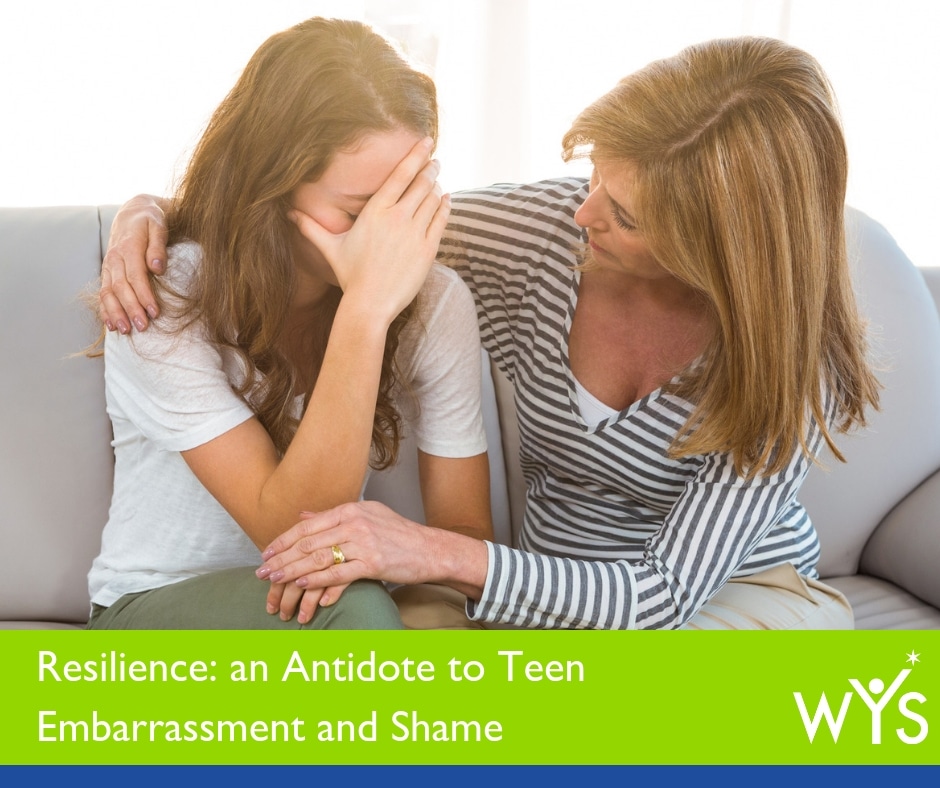
Resilience: an Antidote to Embarrassment and Shame
Many emotions occur as teens are developing their sense of self and finding their confidence; some struggle with embarrassment and shame. Research notes that it is during this time of life that our propensity to compare ourselves to others, self-reflect and feel sensitivity toward other people’s opinions is at a high.
Embarrassment is one of those common emotions that teens feel. It is the feeling frequently experienced after a real or perceived mistake. Often it is associated with feelings of guilt and remorse. When adolescents feel embarrassed and guilty, it can be a good thing because it is their conscience telling them that they did something against their own values. In that case, it is a healthy response.
Trauma and Shame
For adolescents that have been exposed to adverse childhood experiences (ACEs), embarrassment and guilt, can be experienced as shame. Shame is a painful emotion that originates from a deep-seated belief that one is lesser than, bad, wrong, or unworthy. It is different from guilt, which is focused outwardly on the behavior. Shame might accompany other beliefs about oneself that he/she/they is/are deserving of disapproval, condemnation, or rejection.
Trauma affects the way a child’s brain develops. Often it can make it more difficult to control emotions, or make them more impulsive than other children. For example, a teen who has been sexually abused may engage in risky behaviors due to their response to trauma. They may have multiple sex partners and/or experiment with drugs or alcohol, and be at greater risk for sexually transmitted diseases. The behaviors themselves may be a normal reaction to an abnormal circumstance, as they try to find ways to avoid the shame that surrounds their past trauma. As a result of their risky behaviors, others might say hurtful and shameful things about them. They might even use shameful self-talk, associating their identity with the risky behavior(s).
This deep, internal belief that “I am bad” is hard to shake. Some youth that come to Western Youth Services have expressed that even when they are involved in community leadership programs, they feel like their true self is the kid that does or did “bad” things, and the “leader” that they portray to their community is their “fake self.” This belief perpetuates the shame and embarrassment because they feel like they are a fraud. Chronic feelings of shame can lead to self-loathing and social withdrawal. Shame can continue in a downward spiral, ultimately leading to suicidal thoughts. Sadly, feeling ashamed of oneself is one of the most overlooked connections to mental health concerns, including suicide. In the Ted Talk titled Listening to Shame, sociologist Brené Brown, explains that she found through 16 years of research, that shame is correlated with addiction, depression, eating disorders, violence, suicide, bullying, and aggression.
Shame and Resilience
For friends, family and community members that want to care for teens who act out from a place of shame, there are some things we can do to help:
-
Avoid judgement
The number one thing that we need to be mindful of is to not perpetuate their embarrassment and shame by making them feel bad about their choices. Brené Brown says that “if you put shame in a petri dish, it needs three things to grow exponentially: secrecy, silence, and judgement.” Instead of asking the question, “What is wrong with you?” we can ask, “What happened to you, and how can I help?”
-
Try to understand
One very important thing to remember when supporting teens is to try to understand the underlying thoughts and contributing factors behind their actions. For example, a normal reaction to sexual abuse trauma can be an increase in sexual behavior as a way of connecting with others, or essentially, seeking love. Negatively judging a teen for their behavior will hinder one’s ability to help them. If we are able to let go of the need to control their behavior and instead approach them with compassion and empathy, they are more likely to feel cared for and understood. The basis for feeling loved and having a sense of belonging is when a person feels understood. This is often what hurting adolescents are searching for through their risky behaviors.
-
Practice empathy
Empathy is different from sympathy. Sympathy is feeling sorry for someone, while empathy is “putting yourself in another person’s shoes”. When we have experienced the same thing as another, we have a greater propensity to feel empathetic towards them. But you don’t actually have to have the same experience to be able to be empathetic. When you seek to understand where the other person is coming from, you can build empathy. One way to do this, is to think back to a situation where you felt shame about something. Remembering the discomfort of that feeling and considering how your struggling teen may be feeling similarly is empathy. Watch this short video by Brené Brown that cleverly explains the difference of sympathy and empathy:
-
Seek mental health help
For some youth, understanding and practicing empathy is not enough — especially for teens that are feeling hopeless about their lives. Some may need the support of a trained counselor to heal from traumatic experiences. Any teen that expresses suicidal thoughts (ideation) needs to be taken seriously. Almost everyone who has successfully completed suicide has talked about it in the past. If you or someone you care about is struggling, call or text the National Suicide Hotline for guidance: 800-273-8255.
What healing can look like
I am reminded of Natalie, one of our clients, whose story highlights the journey of healing possible for those struggling with shame caused by adverse childhood experiences.

Natalie came to Western Youth Services because she was starting to get into trouble at home and at school for losing her temper and shouting at her family and friends. She wanted help but wasn’t sure what that meant. Natalie explained that she felt a deep sadness most days and was confused about her sexual identity. She was also struggling with feelings of embarrassment and shame as memories of sexual abuse that spanned several years during her childhood were beginning to surface. She started using drugs and alcohol to try to help her feel better but it did not seem to be working.
Her WYS counselor helped Natalie heal from the effects of the sexual abuse trauma by using art therapy. Through writing and drawing, she began to explore the most significant aspects of the abuse. Natalie was able to write down her trauma story and eventually share it with her mother and sister, which provided a way for them to understand and support her healing journey. Over time, Natalie recognized the negative thoughts about herself that were created as a result of being abused. She began the process of actively changing her thoughts to more accurate positive thoughts.
She ultimately became more social and confident, and she made new, positive friendships. Her mood got lighter and she stopped using drugs and alcohol. Once she realized she could use acting as an outlet for her emotions, she flourished, and landed two significant roles in the film industry!
Building resilience requires the reliable presence of at least one supportive relationship. Sometimes, the sheer act of being heard and having a safe and dependable person to talk with can help teens. What ways have you learned to build resiliency against shame in your life and community? Connect with us on Facebook and let us know.







